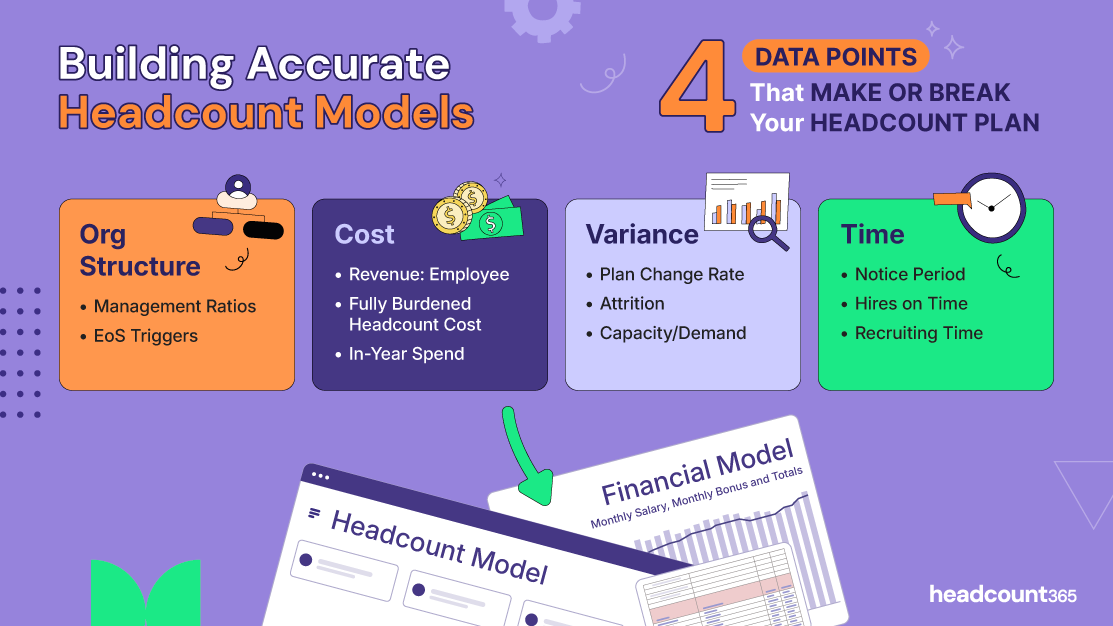4 Data Points Critical for Your Headcount Model
Table of Contents
Spreadsheets don’t preserve context—what changed, when, and why. This is critical context for future headcount models who’s accuracy relies on the rate of change.
Headcount software creates data critical for headcount models
Spreadsheets capture the last known value, while software gives you you the entire history of a requisition or headcount. headcount365’s requisition activity feed houses all change data for a more accurate picture of how change impacts headcount.
This variance data creates more detailed insights into how plans evolve, so FP&A & WFP teams can build more accurate, more defensible models. Whether you’re using our system or a spreadsheet, here are insights you can be looking for from the headcount variance that will improve the accuracy of your future models.
4 data categories that improve headcount models:
1. Org Structure
What it is:
The arrangement of people within your organization, including how roles and reporting lines are structured.
Why it matters:
Org structure drives management efficiency, productivity, and operational complexity. Metrics like span of control and defined scaling thresholds help prevent over-hiring, under-supporting, or building teams that aren’t sustainable. Without a clear model for how the org should scale, hiring becomes reactive and misaligned with business needs.A headcount plan is a production plan—how people are arranged to deliver outcomes.
Critical Metrics
Management Ratios & Span of Control
Planning by title alone hides structural issues. Every plan should define ideal spans of control and flag when teams become over-managed or under-supported.Economies of Scale Triggers
Certain roles scale until a threshold is met. For example, a recruiter can self-manage interview scheduling—until they can’t. How many interviews necessitate the need for a scheduling tool? How many before you need a coordinator?
Ratio-based scaling helps teams hire efficiently, ensuring productivity doesn’t suffer by over-relying on generalists before introducing specialists.
2. Cost
What it is:
The financial impact of headcount, including direct and indirect costs.
Why it matters:
Headcount is one of the largest expenses in most companies. Accurately modeling cost—by role, department, or hire date—ensures budget accuracy and prevents surprises. It also allows for smarter tradeoffs between headcount and other business investments. Without this, Finance and Talent teams are left speaking different languages. Every hire carries financial weight—and how you count it matters.
Critical Metrics
Revenue per Employee
This metric ties people cost to output. It's especially useful in headcount vs. revenue models where productivity targets inform hiring limits.Fully Burdened Headcount Cost
Models should go beyond salary. Include equity, benefits, taxes, and any location-specific cost multipliers to get a true sense of financial impact.In-Year Spend
Planning for future roles isn’t enough—you need to know when they’ll hit the books. In-year cost modeling ties start dates to actual spend, not annualized cost, helping Finance plan cash flow more accurately.
3. Variance
What it is:
The gap between what was planned and what actually happened—across hiring, attrition, and headcount changes.
Why it matters:
No plan survives contact with reality. That’s why headcount365 delviers real-time insight into plan progress.
Measuring variance gives visibility into how your plan performs over time and helps you model future risk. Teams that track variance can forecast with greater confidence, adjust faster, and reduce friction between Talent, Finance, and functional leaders.
Critical Metrics
Plan Change Rate
How often do roles change from the original plan? Tracking this tells you how predictable your plan is—and how much buffer you need.Attrition
Attrition isn’t linear. If 24 employees attrit, its rarely 2 per month, especially when considering equity vesting schedules, bonus payouts and commission plans. Historical attrition helps model backfills and hiring velocity more realistically.Recruiting Capacity vs. Demand
It doesn’t matter how many roles are planned—only how many can actually be hired. This is the most common blind spot in workforce models. Future models should account for recruiter bandwidth and open req capacity before forecasting delivery.
4. Time
What it is:
The timing dynamics that influence when people are hired, start, or leave.
Why it matters:
Models built on headcount alone miss critical timing variables like time-to-fill, notice periods, and ramp time. These differences impact when spend hits the budget and when work gets done. Accurate time modeling helps align expectations across Finance, Recruiting, and functional teams—especially when timing is tight.
Critical Metrics
Notice Periods
Senior hires take longer to leave their job and ramp up in yours. Location, level, and function all influence the real start date. Models should reflect that lag.
Hires on Time
Historical performance on hiring deadlines is your best predictor of future accuracy. Tracking this gives teams a realistic sense of risk in any plan.Recruiting Time
Some roles take 30 days to fill. Others take 180. This variability matters. Use historical time-to-hire by function and level to improve the precision of your timeline.
headcount365 headcount models are 50% more accurate than spreadsheets
Most teams don’t fail because they had the wrong strategy. They fail because poor data led to wrong assumptions.
The plan I made will never change
The changes that happened were one off and shouldn’t be incorporated into future models
The changes I made respected the budget we set
Better headcount models start with better inputs. The better your headcount software can track org structure, cost, variance, and time—the closer your future model will match reality. Spreadsheet limitations permeate future plans, and it’s time for a change. Not only does headcount365 unlock this data for you and your team, it’s intelligence engine will help apply it to future models for more accurate, reliable headcount models.

